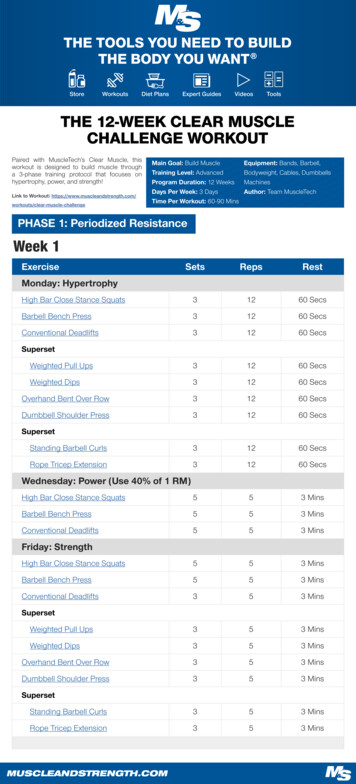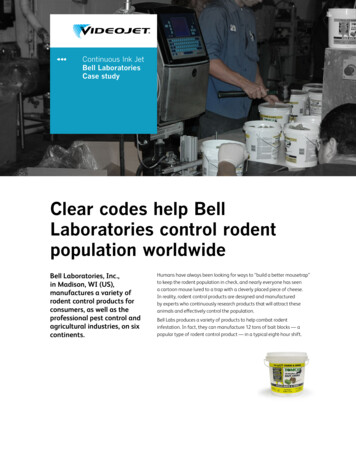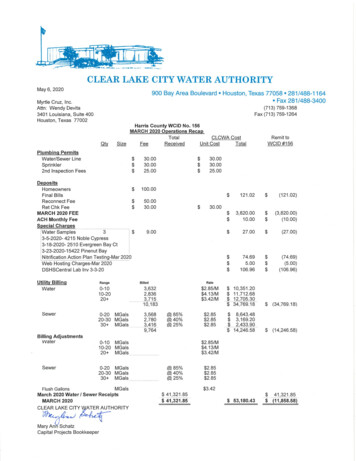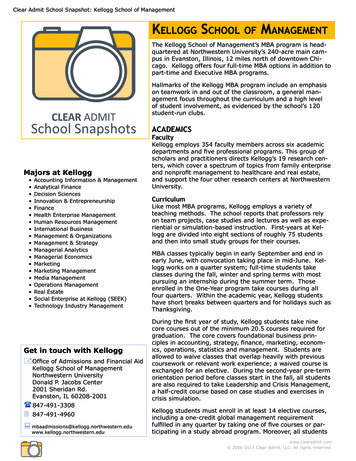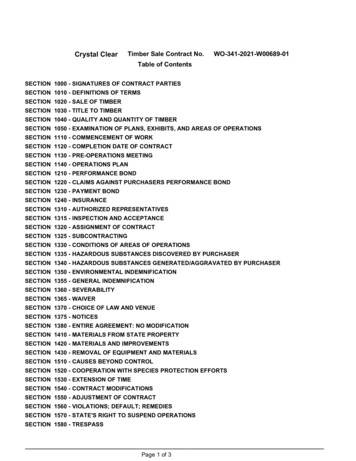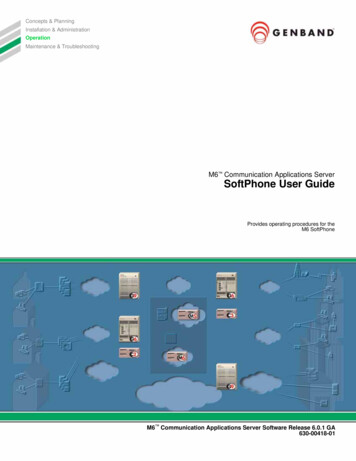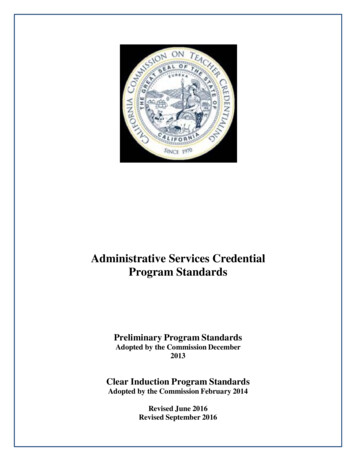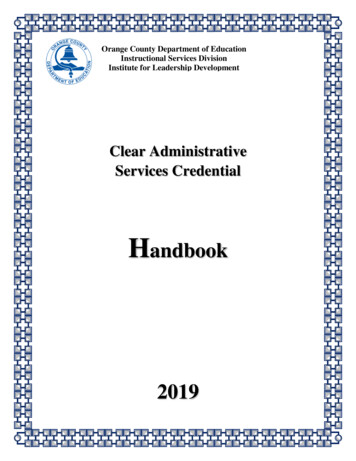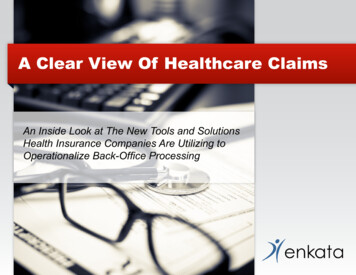
Transcription
A Clear View Of Healthcare ClaimsAn Inside Look at The New Tools and SolutionsHealth Insurance Companies Are Utilizing toOperationalize Back-Office Processing
Healthcare organizations today are challenged to process highvolumes of claims quickly and accurately. However, the reality ismost insurance companies struggle with a system for claims thatinvolves confusing, complex steps and manual procedures. ThisEliminating claims errors wouldsave 17 billion annually.- National Health Insurer Report Card, AMA, 2011often results in an error-prone, inefficient structure with dramaticvariations in performance.To address this growing complexity, managers and quality auditors have been looking for ways to increase accuracy,efficiency and visibility into claims analysis and management.The goal is to stop claims operational issues before they start by monitoring and actively managing processorbehaviors and productivity, and identifying opportunities to improve accuracy, compliance and productivity.Having a way to operationalize back-office claims processing and reduce the steps needed to process claimspresents a significant opportunity for health insurance companies to increase ROI.By deploying back-office analytics, which literally record the screen of processors, tracks processor desktopbehaviors, and automates tedious time consuming tasks, healthcare insurancecompanies have been able to systematically improve claims processor accuracy,compliance and productivity.According to an analysis of sixcommercial insurers, the averageclaims-processing error rate for the sixcommercial insurers that were analyzedboth in 2010 and 2011 was 19.3%—anincrease of 2% over last year.This E-book will address the current realities and challenges healthcare providers arefacing with healthcare claims management. It will highlight the cutting-edge tools andsolutions leading healthcare providers are using to have visibility into common errorsand take corrective measures to address the inefficiencies.- National Health Insurer Report Card, AMA2
Challenges/Opportunities With CurrentHealthcare Claims Analysis ModelsResearch shows that every error on a healthcare claim can be acostly one. According to the annual National Health Insurer ReportCard (See Sidebar: Current Claims Processing Gets Poor Grades)published by the American Medical Association (AMA), 19.3%of medical claims processed by the nation’s largest commercialhealth insurers is inaccurate. The report found a 2% rise in claimsprocessing errors over last year’s findings, which added anThe AMA found a 2% rise inclaims processing errors overlast year’s findings, which addedan estimated 1.5 billion inunnecessary administrative coststo the health system.- National Health Insurer Report Card, AMAestimated 1.5 billion in unnecessary administrative costs to thehealth system. The AMA estimates that if all health insurers were able to eliminate all claim payment errors, the healthcare system would save 17 billion a year.The reality is the majority of avoidable healthcare claims errors are the result of manual mistakes — an inefficiency thatcan be addressed.In addition, the claims analysis issue is only getting more complex, and provider visibility into problem areas does notexist today. The increasing compliance requirements require greater documentation and create the potential for anincreased number of costly errors.Fact: Most healthcare organizations lack the basic operational metrics found in otherindustries such as Claim Adjustment Rate, measured at the processor level. Withoutthese critical metrics, managers don’t have the operational knowledge they need toimprove quality levels. Managers are forced to spend extra time and money spotchecking and auditing claims processors as a stop-gap solution.3
In the current model, health insurance providers have to performforensics on each claim in order to go back and understand thetrail of who processed the claim and where the error occurred.Attaining higher claims accuracy and a consistent approachamong claims processors is in everyone’s best interest, especiallyfor insurers that can reduce claims adjustment costs, penalties,With complete visibilityinto the current processes,managers and auditors areable to automate the next bestactions to improve the speedand accuracy with whichclaims are processed.interest and call-center costs from better claims accuracy.The good news is that analytics solutions are enabling healthcare providers to create automated workflows, which arehelping to reduce costs and claims errors. Desktop analytics enable healthcare insurance companies to easily traceback to where an error occurred and correct the problem using performance management tools.With complete visibility into the current processes, managers and auditors can establish best practices forperformance management. They can then operationalize these best practices and processes and automatethe next-best actions to improve the speed and accuracy with which claims are processed.These tools have improved the ability to: Identify the best practices by claim type from high quality/highthroughput processors. Offer visibility into the work habits of high throughout/highquality processors. Provide visibility into the step-by-step processing actions ofprocessors for incorrectly paid claims.4
Current Claims Processing Gets Poor GradesFrom AMAReport CardConsider the facts from a recent American MedicalAssociation’s Health Insurer Report Card thatcompiled a random sampling of approximately 2.4 million electronic claims accumulated from more than400 physician practices in 80 medical specialtiesproviding care in 42 states: Estimates of the growingincrease in inaccurateclaim payments will costthe healthcare industry anadditional 1.5 billion inneedless administrativeexpenses in 2011 alone. On average, mistakes occur in 5% to 10% of all claims submitted. Healthcare claims errors waste billions of dollars every year. Estimates of the growingincrease in inaccurate claim payments will cost the healthcare industry an additional 1.5billion in needless administrative expenses in 2011 alone. The U.S. healthcare system wastes between 600 billion and 850 billion annually due toerrors and inefficiency. The majority of insurers failed to improve their accuracy rating in this year’s report versuslast year.5
Next Gen Healthcare Claims ManagementNew, automated claims analysis solutions allow companies to leverage theinnovation of the cloud to reach disparate, back-office claims processingoperation anywhere, at any time, across all technologies and locations.By eliminating the need for capital expenditures or on-premisemaintenance – and minimizing IT investment – these cloudbased solutions accelerate project funding and implementation bymaking these workflow tools palatable and scalable for healthcareorganizations of all sizes.Companies who haveadopted these automatedtools and processes havebenefitted from increasedefficiency and accuracy byeliminating time consuming,error-laden claims processingsteps such as cutting andpasting information.Companies who have adopted these automated tools and processeshave benefitted from increased efficiency and accuracy by eliminating time consuming, error-laden claims processingsteps such as cutting and pasting information.The closed-loop performance management transforms the claim audit process from “forensic science” to arepeatable, operational system for processing and analyzing complete claims.6
A Breakdown OfThe Typical Claims Analysis By RoleThe “old” claims analysis model looks like this: Prioritize and distribute claims.Cl ai m Wor ke d byProc es so rCla im Fin alized byProc es so r Claims are worked by processors. Claims are finalized by the processor. Potential error(s) are identified by the provider. The claim is updated/resubmitted for adjustment.Potentia l Er ro r(s)rIde ntified by th e Prov ideCla im Updated/Resu bm ittedfor Adjustm entWith the new, automated model, processors are visually reminded on their desktop of criticalprocessing steps, and those steps are automatically performed to drastically reduce errors.These tools enable healthcare providers to put operationalized performance management in place,which provides visibility into activity at the desktop level.These new automated solutions provide real-time guidance to achieve operational goals via desktopautomation and eliminate the need to work backwards to try and understand events or to develop ahypothesis of events surrounding a claim.7
Claim Analysis By RoleThrough the use of screen recording technology, an analyst or manager can now literally “see” what happened onthe claims processor’s screen, eliminating the painful and time-consuming process of sifting back through papertrails and reports.Automating the claims process redefines every step of the health care claim analysis. And by doing so, it reshapes therole of everyone involved in processing a claim.With real-time guidance, the claims processing operation functions more efficiently, and each role has greater visibilityinto shared workflows and best practices. Here is a look at the benefits by role: Processors can review their own behavior and productivity scores, which allows them to make the rightchanges in their own workflow and correct their own behaviors. Managers/Supervisors can see problems within claim categories or by reason of denial of claims viaa screening processor. They also can identify problem areas in quality and/or bad behavior patterns, andimplement targeted coaching to help increase team productivity. Analysts can identify root cause of claims rework, predict workload based on historical data, and get insightin order to make adjustments. Auditors/Quality Monitors will be provided with visibility into each manually adjusted claim. They cansearch by claim id, see a list of actions taken on certain claim, and play screen recordings of full life cycleof a claim.8
New Models: Combining Actionable Data WithTargeted Coaching & Performance ManagementMeasureAutomated solutions are cost-effective and drive a higher ROI than thecurrent manual, error-prone processes currently employed by mosthealthcare providers.VerifyIdenBy adding analytics, screen recording and coaching/performancetifymanagement, automated tools support repeatable workflows by: Measuring performance (behaviors, value add metrics, etc.)Target Identifying problem areas (claim types, time of day, etc.) Drilling to actual claims/non-processing segments Performing targeted processor coaching Verifying processor improvement, thus re-evaluating coachingCoaching sessions can be created from the dashboard and Next Best Action report. This allowsmanagers to drive more effective training sessions.9
Next Gen Health Care Claims ManagementIn addition to improved accuracy, compliance, recording of claims process,automation reduces costs with improved efficiency, accuracy, and cycle times.By utilizing desktop analytics, automation, and screen recording, in addition toperformance management, leading companies are reducing errors as well asclaims errors.An automated and repeatable structure to claims also streamlines audits andleverages existing controls to comply with new and changing regulations, preventsSLA and compliance violations and corresponding lost revenue, and improvesbusiness relationships while enhancing customer service.10
Here is an example of how automated healthcare claims analysiscan improve a healthcare claims organization’s performance bygaining visibility into the claims management process.Following implementation,the company hasexperienced an increasein claims processorthroughput, a 20% boostin auditor efficiency and a5% reduction in the claimsadjustment rate per year.A large health insurance company processes millions ofclaims per month across its multiple claim processing centersnationwide. Many of these processors work from their homeoffices and have very little interaction with management. Dueto a lack of visibility, the company cannot view steps taken byprocessors if they incorrectly process a paid claim. Furthermore,the company cannot observe the work habits of high-performingprocessors and identify these best practices to improve the performance of lower-performingprocessors, improve policies, and establish operational best practices.In order to improve claims payment accuracy and lower the overall cost to pay a claim, thecompany deploys a claims management solution. Now management has complete visibilityinto processor desktop activity to properly identify best practices and compliance violationsfor coaching and training. The solution also provides a screen capture for auditors to view anduncover any payment-processing errors that may occur.Following implementation, the company has experienced an increase in claims processorthroughput, a 20% boost in auditor efficiency and a 5% reduction in the claims adjustment rateper year.11
Conclusion:Using Analytics To Drive Next Best ActionIn the healthcare sector, change has become the norm due to reforms. Healthcare providers now need to consistentlymeasure improvement nearly every area of the enterprise. Insurance companies are under continual pressure to improveperformance and visibility, as well as compliance for any type of oversight. With so many areas to address seemingly allat once, analytics capabilities are imperative.Analytics and automation helps providers aggressively demonstrate a measured improvement by streamliningoperations, uncovering process gaps, and raising the bar on medical loss ratios and interaction improvements acrossmember servicing.In the current environment, most insurance companies are operating in the dark with no real visibility into where errorsand problems are causing inefficiencies. With next-generation healthcare claims management, auditors and managerswill have “next best action,” capab
Healthcare claims errors waste billions of dollars every year. Estimates of the growing increase in inaccurate claim payments will cost the healthcare industry an additional 1.5 billion in needless administrative expenses in 2011 alone. The U.S. healthcare system wastes between 600 billion and 850 billion annually due to errors and inefficiency. The majority of insurers failed to improve .
![Fluent Python : [clear, concise, and effective programming]](/img/1/799981060.jpg)
